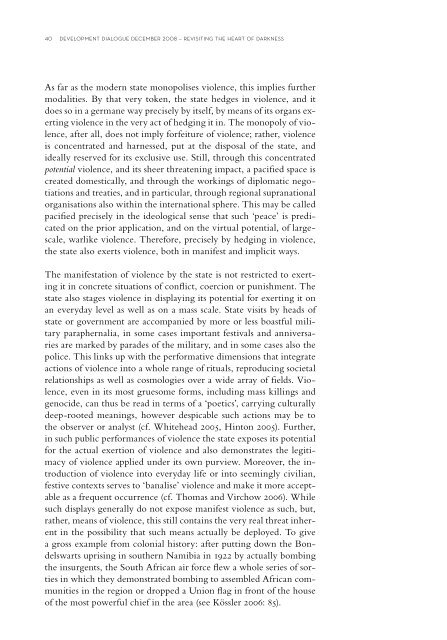60 years after the UN Convention - Dag Hammarskjöld Foundation
60 years after the UN Convention - Dag Hammarskjöld Foundation
60 years after the UN Convention - Dag Hammarskjöld Foundation
You also want an ePaper? Increase the reach of your titles
YUMPU automatically turns print PDFs into web optimized ePapers that Google loves.
40 development dialogue december 2008 – revisiting <strong>the</strong> heart of darkness<br />
As far as <strong>the</strong> modern state monopolises violence, this implies fur<strong>the</strong>r<br />
modalities. By that very token, <strong>the</strong> state hedges in violence, and it<br />
does so in a germane way precisely by itself, by means of its organs exerting<br />
violence in <strong>the</strong> very act of hedging it in. The monopoly of violence,<br />
<strong>after</strong> all, does not imply forfeiture of violence; ra<strong>the</strong>r, violence<br />
is concentrated and harnessed, put at <strong>the</strong> disposal of <strong>the</strong> state, and<br />
ideally reserved for its exclusive use. Still, through this concentrated<br />
potential violence, and its sheer threatening impact, a pacifi ed space is<br />
created domestically, and through <strong>the</strong> workings of diplomatic negotiations<br />
and treaties, and in particular, through regional supranational<br />
organisations also within <strong>the</strong> international sphere. This may be called<br />
pacifi ed precisely in <strong>the</strong> ideological sense that such ‘peace’ is predicated<br />
on <strong>the</strong> prior application, and on <strong>the</strong> virtual potential, of largescale,<br />
warlike violence. Therefore, precisely by hedging in violence,<br />
<strong>the</strong> state also exerts violence, both in manifest and implicit ways.<br />
The manifestation of violence by <strong>the</strong> state is not restricted to exerting<br />
it in concrete situations of confl ict, coercion or punishment. The<br />
state also stages violence in displaying its potential for exerting it on<br />
an everyday level as well as on a mass scale. State visits by heads of<br />
state or government are accompanied by more or less boastful military<br />
paraphernalia, in some cases important festivals and anniversaries<br />
are marked by parades of <strong>the</strong> military, and in some cases also <strong>the</strong><br />
police. This links up with <strong>the</strong> performative dimensions that integrate<br />
actions of violence into a whole range of rituals, reproducing societal<br />
relationships as well as cosmologies over a wide array of fi elds. Violence,<br />
even in its most gruesome forms, including mass killings and<br />
genocide, can thus be read in terms of a ‘poetics’, carrying culturally<br />
deep-rooted meanings, however despicable such actions may be to<br />
<strong>the</strong> observer or analyst (cf. Whitehead 2005, Hinton 2005). Fur<strong>the</strong>r,<br />
in such public performances of violence <strong>the</strong> state exposes its potential<br />
for <strong>the</strong> actual exertion of violence and also demonstrates <strong>the</strong> legitimacy<br />
of violence applied under its own purview. Moreover, <strong>the</strong> introduction<br />
of violence into everyday life or into seemingly civilian,<br />
festive contexts serves to ‘banalise’ violence and make it more acceptable<br />
as a frequent occurrence (cf. Thomas and Virchow 2006). While<br />
such displays generally do not expose manifest violence as such, but,<br />
ra<strong>the</strong>r, means of violence, this still contains <strong>the</strong> very real threat inherent<br />
in <strong>the</strong> possibility that such means actually be deployed. To give<br />
a gross example from colonial history: <strong>after</strong> putting down <strong>the</strong> Bondelswarts<br />
uprising in sou<strong>the</strong>rn Namibia in 1922 by actually bombing<br />
<strong>the</strong> insurgents, <strong>the</strong> South African air force fl ew a whole series of sorties<br />
in which <strong>the</strong>y demonstrated bombing to assembled African communities<br />
in <strong>the</strong> region or dropped a Union fl ag in front of <strong>the</strong> house<br />
of <strong>the</strong> most powerful chief in <strong>the</strong> area (see Kössler 2006: 85).

















